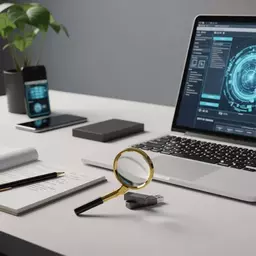Understanding Legal Frameworks
- •GDPR: Data protection & privacy in EU.
- •ECPA: US law on electronic comms.
- •HIPAA: Healthcare data for IoT devices.
Stay informed with expert insights on forensic investigations, fraud detection, and legal evidence handling. Subscribe for clarity in complex situations.
Posted on: 2025-10-16
By: Clara Ashford
What if the next big breakthrough in forensic investigation comes from analyzing data collected by your smart devices? In an age where every aspect of our lives is interconnected, understanding IoT forensics could be the key to unraveling complex cases.
Navigating the evolving landscape of IoT forensics involves addressing critical legal frameworks, privacy concerns, and maintaining a robust chain of custody. To further understand the broader context of digital evidence, explore data recovery for legal proceedings.
As the world becomes more interconnected, the importance of data analysis in investigative processes cannot be overstated. IoT forensics plays a critical role in uncovering crucial information from connected devices, which can significantly impact various investigations. At TC Forensic Investigations, we understand that navigating the complex landscape of IoT data is essential for providing accurate insights and solutions.
But what exactly is IoT forensics? This emerging field focuses on analyzing data from Internet of Things (IoT) devices to gather evidence for legal and corporate investigations. With the proliferation of smart devices, this specialized forensic analysis is becoming an integral part of our investigative approach.
Simply put, IoT forensics involves the collection, preservation, and analysis of data from IoT devices. This data can include everything from sensor readings to user activity logs. Understanding this aspect of forensics is vital because it allows investigators to piece together events leading to a specific incident. When we work with clients, we emphasize the importance of comprehensive data analysis to reveal the full story. For further reading on related topics, consider our article on digital forensics 101: an introductory guide to cyber investigations.
In our experience at TC Forensic Investigations, having access to diverse data sources—like wearables, smart home devices, and even connected vehicles—can profoundly enrich an investigation's outcome.
Connected devices are ubiquitous in our daily lives, capturing data that can be pivotal in investigations. These devices, whether it's a smart thermostat or a fitness tracker, generate a wealth of information that can reveal patterns of behavior. As a forensic investigator, I often find that these insights can be the keys to unlocking crucial leads.
By analyzing data from these sources, we can provide clients with a clearer picture of events, helping them make informed decisions moving forward. It’s fascinating how each device contributes to the mosaic of evidence!
While the potential for uncovering valuable insights through IoT forensics is immense, it also raises significant data privacy and ethical concerns. As I navigate these waters at TC Forensic Investigations, I remain acutely aware of the balance needed between thorough investigation and respecting individuals' privacy rights.
By prioritizing ethical practices, we not only protect our clients but also reinforce the integrity of our investigative process. This commitment is at the core of what we do, ensuring that our findings are trustworthy and valuable.
In the realm of IoT forensics, always prioritize data integrity. Regularly update your forensic tools and techniques to keep up with evolving technology. This ensures that the evidence collected remains credible and can withstand legal scrutiny.
As the landscape of IoT forensics continues to evolve, so too do the legal and ethical challenges that come with it. It’s crucial to understand the frameworks that govern how we handle data collected from various Internet of Things devices. This understanding not only informs best practices but also ensures that investigations respect privacy rights and maintain integrity.
Having worked in forensics for over a decade, I’ve seen how vital it is to stay updated on these legal standards. By navigating the complexities of IoT forensics with a keen awareness of the law, we can better serve our clients at TC Forensic Investigations and uphold the standards of professionalism that define our work.
The legal landscape surrounding IoT forensics is multifaceted, influenced by both local and international regulations. Standardization helps ensure that forensic practices are consistent and reliable. Key frameworks include:
By adhering to these regulations, we can conduct investigations that not only yield valuable insights but also respect individuals' rights and privacy.
Data collection from IoT devices raises significant privacy concerns. As someone deeply committed to integrity, I understand that ethical challenges arise when gathering evidence from personal devices. It's vital to consider:
Addressing these ethical challenges helps to build trust with clients and the public, ensuring that our investigative practices are not only effective but also responsible. For a deeper dive into protecting sensitive information, read about data protection strategies for sensitive information.
The chain of custody is crucial in legal contexts, especially in IoT forensics. It refers to the process of maintaining and documenting the handling of evidence. A solid chain of custody ensures that the evidence can withstand scrutiny in court. This involves:
At TC Forensic Investigations, we prioritize maintaining a strict chain of custody to fortify the reliability of our findings, ultimately enhancing the strength of our clients' cases.
Here are some frequently asked questions about IoT forensics, addressing common concerns and providing clarity on this evolving field.
IoT forensics is a specialized field focused on the collection, preservation, and analysis of data from Internet of Things (IoT) devices to gather evidence for legal and corporate investigations. This includes data from smart devices like wearables, smart home systems, and connected vehicles.
It's crucial because IoT devices generate vast amounts of data that can help establish timelines of events, uncover hidden relationships between devices, and identify potential evidence of wrongdoing, significantly enriching the outcome of an investigation.
Key legal frameworks include the General Data Protection Regulation (GDPR) for data protection in the EU, the Electronic Communications Privacy Act (ECPA) in the US for electronic communications, and HIPAA for IoT devices handling healthcare data.
Primary concerns include ensuring informed consent for data collection, practicing data minimization (collecting only necessary data), and maintaining transparency about how data will be used and protected. Balancing thorough investigation with respecting privacy rights is paramount.
The chain of custody is the documented process of handling evidence from collection to presentation in court. It's vital for ensuring the evidence's validity and credibility in legal proceedings, involving detailed records of who collected, secured, and handled the data.
Looking ahead, the field of IoT forensics is set to undergo dramatic changes. Embracing these trends not only enhances our investigative capabilities but also prepares us for the challenges of tomorrow. As we continue to evolve, it's essential to stay informed about the latest advancements. Understanding the intricacies of the DFIR process from incident to resolution can provide valuable context for these future developments.
Here is a quick recap of the important points discussed in the article:



 In a world where cyber threats are constantly evolving, the need for effective digital forensics has
In a world where cyber threats are constantly evolving, the need for effective digital forensics has
 Understanding the nuances of synthetic identity fraud is essential in today's digital age. As frauds
Understanding the nuances of synthetic identity fraud is essential in today's digital age. As frauds
 In the competitive landscape of corporate investigations, the choice of a private investigator can m
In the competitive landscape of corporate investigations, the choice of a private investigator can m